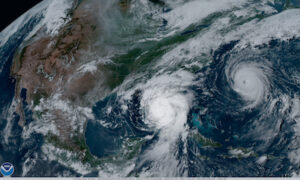Who is a member?
Our members are the local governments of Massachusetts and their elected and appointed leadership.

Satellite imagery captures Hurricane Idalia, left, approaching the western coast of Florida on Aug. 29, 2023, while Hurricane Franklin churns in the Atlantic Ocean. Meteorologists are forecasting a volatile hurricane season this year. (Image courtesy National Oceanic and Atmospheric Administration)
As we enter the busiest months of the annual hurricane season, meteorologists are forecasting a season with the potential to be more volatile than usual. Even if the Northeast coastline does not see a direct hit, inland areas are not immune from the effects of more temperamental, damaging storms.
The combination of rising North Atlantic Ocean temperatures and an emerging La Niña climate pattern, which pushes the jet stream north and creates an ideal environment for hurricanes, is expected to create a record number of storms. The National Oceanic and Atmospheric Administration has predicted 17 to 25 named tropical storms for the season, with eight to 13 of them expected to become hurricanes, and four to seven of them expected to reach Category 3 or above. Hurricane Beryl, which formed relatively early this season, serves as an example of how these “perfect storm” conditions are making an impact.
The NOAA does not predict by region, but Boston-area forecasters expect that at least one tropical storm will make landfall in the area this season, and noted meteorology experts at Colorado State University say there is a 49% chance of a named storm impacting the Northeast this year.
First Street Foundation, a national nonprofit that focuses on assessing flood risk, forecasts that northward movement of hurricane activity will cause annual damages in the Northeast region to increase by 87% over the next 30 years, with buildings that have not been built to code for higher wind speeds at much higher risk.
Stronger storms that produce more sustained downpours and flash floods have increased greatly over the past several decades. These more dangerous storms bring increased chances of widespread water damage to inland areas that were previously considered safe from tropical storms. Last September, the city of Leominster faced a catastrophic 11 inches of rain over a two-day period that had adverse impacts on nearly every road, home and business.
Preparation strategies
Stephen Batchelder, MIIA’s vice president of Claims Operations and Risk Management, urges municipalities to act now to prepare for storms that produce higher volumes of rain.
“The sheer volume of water frequently overwhelms existing infrastructure and exploits any age or maintenance-related weaknesses,” he said. “It’s particularly true for older municipal buildings with roofs and foundations nearing the end of their effective life expectancy.”
The following are some key preparedness tasks to consider:
• Inspect roofs for damage and determine if additional fasteners or strapping is necessary.
• Clear drains and gutters to allow water to drain away from buildings.
• Ensure that rooftop and window ventilation and air conditioning units are secured.
• Trim tree limbs near buildings.
• Test generators to ensure they are operational.
• Review backup communication plans, including how residents and employees can be notified if phone lines and computer networks are down.
• Inspect, prepare and maintain all equipment that may be needed during post-storm cleanup, such as chainsaws, sump pumps, and temperature and water sensors.
MIIA partners with Agility Recovery, which provides business continuity and disaster recovery services, to offer preparedness training and testing to its members. Rob Sarno, a senior account manager at Agility, recommends having both an emergency operations plan and a business continuity plan — and ensuring both are tested with redundancy.
“Test your emergency plans thoroughly using tabletop exercises,” he said. “Ask questions, and identify any gaps that your plan may not be addressing.”
Sarno also recommends having a crisis team set up ahead of time, with a designated leader and community volunteers who are vested in the preparedness mission. Also, ensure adequate insurance coverage and share emergency plans with your insurance provider.
“Use insurance providers as trusted consultants,” Sarno said, “as they can help identify gaps in coverage as well as outline expected out-of-pocket costs you could incur if a damaging event occurs.”
Written by Jennifer Ranz